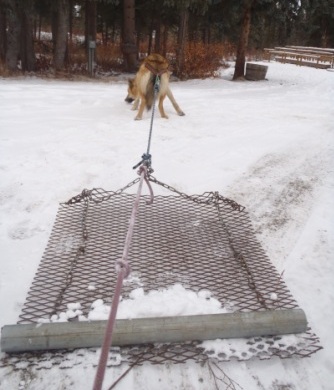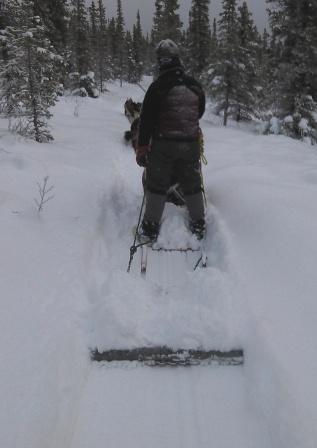by Michael R.
The snow conditions in Denali are highly variable, from not enough snow in the early season, to windblown hard pack, to no snow at all in the places where the wind blew it dry, to dry snow that doesn't compact and feels bottomless if you step off your sled. My sister who lives in Lake Tahoe, sometimes complains about having to shovel snow , even though she is in the snow-removal business. They get upwards of 200 inches of snowfall annually, most of it wet and heavy (nicknamed, Sierra Cement) as the storms come off of the Pacific Ocean. Being in the dry, cold Alaskan Interior, our snow is light in comparison, but we often don't get as much as Lake Tahoe- annually about 80 inches. I joke with her about the fact that I don't have to shovel snow here in the white north, I sweep it!

And I am not the only one who sweeps that light snow around. Here, on the edge of the Alaska Range, we get winds from all directions that will blow a foot of fresh snow away quicker than you can make a snow angel in it. It always amazes our winter visitors to see some of the lower mountains blown bare to brown rock in the middle of winter (this of course is good for the Dall Sheep who can get to their food!). Some of that snow sublimates as it is blown into the air, and the rest gets caught in the willows, alders, swales, and forest edges, often settling in deep drifts. These conditions pose a challenge for Denali mushers to maintain packed, thin, ribbons of snowy trail where we want to run our dogs. But if we can get the trails put in well, when the wind blows the tundra bare we still can move across the tussocks with ease, or when a big storm drops five inches of fresh powder, the dogs can still feel where the trail was before.
And this is where dog mushing can be a drag- maintaining our winter trails. Our sleds are designed as toboggans to "float" on top of the snow for ease of pulling for the dogs. However, when the sled rides high in the deep snow, it does not compact the lower layers of snow. A dog team or two with sleds behind them will thus only lightly compact a trail, unless the trail is used very often, which can disappear with the movement of moisture out of the snowpack during extreme cold. Even if it is a well compacted trail, it ends up being only about as wide as the sled. This is barely enough room for two dogs to run side by side, so some dogs end up pushing their team partner off the trail into the deep snow on the sides ( I won't mention names. Ahem, Pyro ). One solution to maintaining good, wide trails is using snowmobiles. Outside the Wilderness area of Denali NP, mushers have found it a very effective technique that packs the snow in wide swaths. However, since snowmobile use is not allowed in Wilderness, we had to think outside the box to both stay true to maintaining the primeval character of the heart of Denali and to improve our trails.
I have worked for other mushers that are very trail savvy, and let's say, particular about their mushing trails. Their attention to detail makes sense, as a good trail will protect the dogs from fatigue and potential injury if they were to get knocked off the trail by the dog next to them. Several mushers I know like to drag a groomer behind their snowmobiles to further widen and pack the trail.I started thinking, why not drag something behind our dog teams and gain the same benefit? So I designed a simple groomer from a three foot square piece of flat, expanded metal, a piece of old metal pole, and some chain and rope. The expanded metal acts like a cheese grater, grinding up the fluff of the snow, breaking it down, and allowing the bits to fall back through. The pole, which is attached horizontally with the chain at the far end, smoothes out the broken-down snow on the trail evenly while also packing the snow a little and helping to keep the trail mostly level.
The next question became, would my groomer scheme work? Earlier this year after we got a few inches of snow, Pyro and I gave it a shot. I thought, I'll put Pyro in harness, have him pull, and I'll steer the groomer from the back. It was a success on the downhill for a half mile or so, but on the way back uphill I ended up doing more than half the pulling! With the first pass over the snow in, I thought a second pass might be easier, so again I tried a single dog, this time Nuna. It was easier going, but it was apparent that more power would make it even easier. So the next time we took a team out, the groomer came with us. Success! At least pulling it seemed to work well.
Time would tell whether it would produce the desired effect of a compact, slightly wider trail. Almost two months later, a notoriously hard-to-maintain section of our Spring Trail, is almost too easy for the dogs to follow. It is obvious at a break when they flop off to roll in the snow where that trail is solid and safe and where it hasn't been groomed.
So indeed, sometimes mushing can be a drag, but only if you are dragging a trail groomer. The rest of the time it only depends on your perspective in life.


